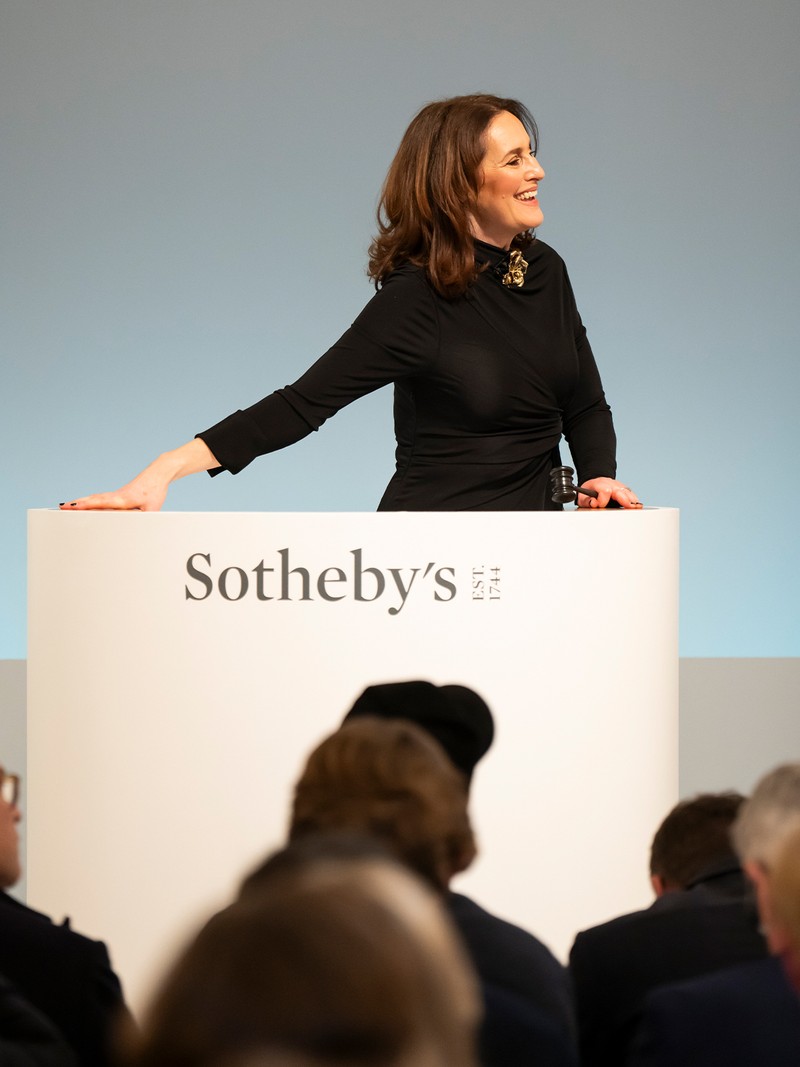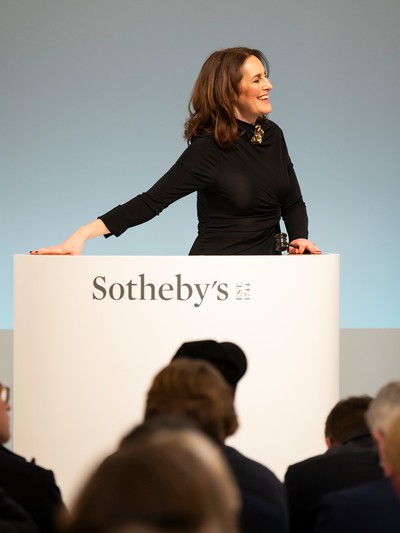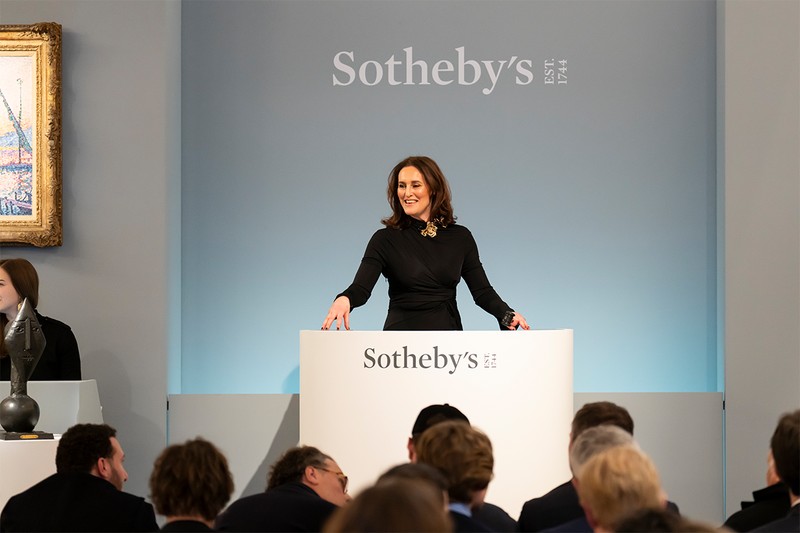

How I Made It: Helena Newman, Chair, Sotheby’s Europe
Becoming chair of Sotheby’s Europe is something that’s evolved over time. As a child, I trained very seriously as a classical violinist, then studied languages and literature at university. I was always interested in art, partly because I was travelling to practise my languages, which gave me an excuse to visit museums in Paris, Vienna and Italy.
I was an undergraduate when Van Gogh’s Sunflowers painting sold – I remember seeing it on the front page of the newspaper. It was national news and the combination of the auction drama, where it came from, where it was going in Japan, and the painting itself… It was captivating.
I thought a career in art would work well with my other interests. I applied to the Sotheby’s graduate trainee scheme and got in straight from university. I remember looking at all these Old Master paintings hung around the room during my interview. I was asked about one of them, and I said it looked Dutch with Italian influences. Apparently, this was a good answer because the artist had spent time in both places – that was the kind of thing Sotheby's was looking for. They wanted to know you had an eye that could be trained.
Today, people tend to arrive as trained art historians. But for me, it was more about translating my interest in literature and poetry into looking at art. My father was a refugee from Vienna and came from a family that was interested in literature, art and music. He was very interested in art and actually met Marc Chagall as a young man in the south of France and befriended him. My parents didn’t have an important art collection or anything though – they were just interested. But our house was full of books – our family friends founded Phaidon Press – and my mother was a concert pianist. I suppose you could say I had a cultured background.
The learning curve on the Sotheby’s graduate scheme was sharp. In those days, people could come into the Sotheby's reception with their artworks and get an opinion – a bit like The Antiques Roadshow. Soon enough, I was one of the people who would go down and look at them. We’d give an opinion or consult with a colleague, and it was a good training ground, simply because of the volume of what was coming through the auction rooms – at that time, we had weekly sales.
After about ten months or so, I got a job as a trainee cataloguer in the Impressionist & Modern Art department. Everyone wanted to work there because that’s where the big-ticket items were. But almost as soon as I started, the market took a downturn. Luckily, the late 1990s and early 2000s offered major growth, and I was lucky to witness the rise of Asia. When I started, we worked almost exclusively with American and European collectors. Now, it's everywhere – Asia, South America, the Middle East.
Starting to auctioneer in my 20s was a significant moment. Taking my first evening auction was a big milestone. I was only the second female auctioneer to take a big evening sale and the first to take a marquee fine art sale in New York in 2016. It’s historically been a very male dominated world – not just in the auctions but also across gallerists and collectors. Thankfully, we now have some very strong female leaders across all of these areas.
It's perfectly possible to have a glittering career in this world without being an auctioneer. It was just something I loved doing because it used my skills as a performer and drew on the different aspects of my musical and theatrical training.
A typical day for me is still focused on the core business of sourcing and selling. I offer advice on potential sales, pricing, and the deals we should actually offer in terms of our guarantees, our risk appetite and so on. I also cultivate our relationships with collectors – some of which are very long-standing – so that when there might be sales, I’m there, ready to advise.
When we’re busy with lots of auctions, my rhythm is slightly different. Either I'm focused on promoting the works, making videos for social media where I talk about the art, or travelling to the sales helping to advise clients. Next week, I'm going to Japan to see several collectors and institutions, which is very exciting. That's my second trip this year. Then I'll be in Paris, and then in New York a couple of times, then longer trips to Asia and the US. The chair role is kind of ambassadorial in a sense – panel talks, hosting lunches and dinners, and attending art world events and openings.
When I started, nothing was written down. You needed to find somebody who could teach you, be at your side, and tell you things – almost like an oral history. You had art-historical monographs and exhibition catalogues, and that was about it. Now, of course, you've got a wealth of amazing information – great websites, journalists, art market professionals – all of whom do incredible work. It’s become much more professionalised. You need to be on Instagram or social media, subscribing to various newsletters and reports. Even so, there's still quite a lot that doesn't get reported, so you still need to be able to pick up things from conversations and build trusted relationships with clients and colleagues. It’s about having your ear to the ground, your finger on the pulse and being in the right place at the right time.
AI is a constant topic of conversation. While it can help with productivity, human influence is still highly valued in our industry – particularly in the art market, because so much of it is about judgement and trust. The big advancement for us is data – especially around pricing, market growth etc. It’s not taken over as such, but it helps. Even if you use it to get a predicted estimate for something, you still need to check your findings and account for all the other aspects the data hasn't put in.
As a boss, I have very high standards. I like things done well and I have high standards for myself, so I'm constantly pushing my colleagues because I know it’s a demanding and competitive field. I quite like that thrill of the commercial chase for the exciting deals. In my current position, it’s less about direct people management and more about setting a tone, a culture and a general strategy for people to believe in.
I've sold a lot of works by Picasso, but I'm always ready to sell more. There are still great works that could come to market again or for the first time. A lot of my dream auctions would revolve around individual great masterpiece lots. That's what really thrills me. Klimt is an artist very close to my heart, as are Kandinsky, Modigliani and Giacometti.
I still love this job. I want to continue at Sotheby’s because I find the access is unprecedented and unmatched. We’ve also had some recent investment from a sovereign wealth fund in Abu Dhabi, so that's going to be quite interesting. There’s a big focus to see what will happen with the Middle East – the museums there are very interested in the blue-chip Impressionist model and in building collections that mirror the great museums of Europe.
I've had some great mentors along the way. But I haven’t been given that much advice – at least not directly. I’ve had to infer it. Ultimately, I think it’s been about being authentic, true to myself and making it work for me. You can always learn from others – I always have – but finding out what works for you is the secret to success.
Visit SOTHEBYS.COM
DISCLAIMER: We endeavour to always credit the correct original source of every image we use. If you think a credit may be incorrect, please contact us at info@sheerluxe.com.


